








Updates to this information are often posted on our online events calendar at GatewayGardener.com, so check there for the latest details.
Give us the details of your upcoming gardening, lawn or landscaping event and we’ll add it to our website and include it in our next issue. Deadline for printing in March 2026 issue is February 1st.
How to reach us:
Mail: PO Box 220853, St. Louis, MO 63122 314-968-3740
Email: info@gatewaygardener.com
Nov. 1st
9am—St. Louis County Parks
Children’s Garden Club: Suncatchers FREE. Planthaven Farms Garden Center, 6703 Telegraph Rd., Oakville. Pre-registration is required on the St. Louis County website at https://tinyurl. com/5n6zx9ex or by calling 314-6154386.
Dec. 6th
9am—St. Louis County Parks
Children’s Garden Club: Holiday Swag Decorating. FREE. Sherwood Forest & Garden Center, 2651 Barrett Station Rd., Ballwin. Pre-registration is required on the St. Louis County website at https:// tinyurl.com/5n6zx9ex or by calling 314615-4386.
Dec. 6th
10:30am-1pm—Santa’s Stop at the Garden for Members. MBG’s littlest members are invited to drop by to say hello and enjoy a cookie, hot chocolate, festive music and hands-on activities in the Bayer Event Center. Registration is not required, activities are included for members with their Garden general admission. Membership card must be presented. Enter through the Bayer Event Center directly to the east of the Jack C. Taylor Visitors Center. Missouri Botanical Garden.
Nov. 1st
10am—Mini Bonsai Garden Learn how to care for Bonsai plants and other miniature plants while you make a miniature garden. You will be whisked away in whimsy with the adorable mini trellis and accents. $60.00. Registration required. Hoffmann-Hillermann Nursery & Florist, 636-239-6729, www. hoffmannhillermann.com.
Nov. 8th
10am—Kokedama. Create a unique
moss ball hanging planter for your home. You will also learn how to care for your Kokedama planter. Registration required. Hoffmann-Hillermann Nursery & Florist, 636-239-6729, www.hoffmannhillermann. com.
Nov. 9th
10am-4pm—Old Webster Holiday Open House. Visit small businesses and restaurants, including Rolling Ridge Nursery, where the Webster Groves Historical Society will host its Holiday Market with crafters and vendors. Refreshments, Christmas tree seedlings and fun for the whole family.
Nov. 15th
10am—Hanging Propagation Station
Make an adorable propagation station for your home. This is a perfect, spacesaving way to start cuttings from your houseplants. $35. Registration required. Hoffmann-Hillermann Nursery & Florist, 636-239-6729, www.hoffmannhillermann. com.
Nov. 15th-Jan. 3rd
Garden Glow. Celebrate the season with one million lights, fun new experiences, and traditional favorites. Enjoy photo opportunities, traditional holiday music and festivities, and delicious food and drinks as the Garden is transformed around you into a winter wonderland. Learn more at glow. missouribotanicalgarden.org. Advance tickets encouraged. Missouri Botanical Garden.
Nov. 15th-Jan.3rd
Holiday Flower and Train Show. Immerse yourself among festive installations of poinsettias and other seasonal favorites presented alongside the newly planted permanent displays of Mediterranean species throughout the Emerson Conservatory. This year’s Holiday Flower and Train Show explores the Victorian era through nature and architecture, highlighted by unique miniature versions of the Garden’s Victorian building and structures made of natural elements. Included with Garden admission and evening Garden Glow. Missouri Botanical Garden.
Nov. 21st, 22nd and 23rd
Hoffmann Hillermann’s Holiday Open House Enjoy a magical experience among beautifully decorated Christmas trees and displays! Get ideas for decorating and great Christmas gifts. A discount of 20% Off Christmas Items and light refreshments is available each day. Enjoy additional attractions on Saturday: see and take pictures with Clydesdale horses, enjoy wine tasting from Augusta Winery, and check out charcuterie board and refreshment offerings from Augusta Emporium.
Make a festive item for yourself or as a gift at one of the classes also available on Saturday (see below) Event location and class registration: HoffmannHillermann Nursery & Florist, 636-2396729, www.hoffmannhillermann.com.
Nov. 22nd
10am—Pinecone Succulent. Turn an ordinary sugar pinecone into a festive, living decoration for your house or office. You will learn how to plant succulents onto the pinecone and how to care for it. Enjoy activities at the Holiday Open House as well! $35. Registration required. Hoffmann-Hillermann Nursery & Florist, 636-239-6729, www.hoffmannhillermann. com.
Nov. 22nd
11:30am—Terrarium Ornament. Make a living ornament. You will make a mini terrarium in a clear ornament. This would be an adorable gift for the plant lover in your life—or bring them along and spend the afternoon making your own gifts together. Enjoy activities at the Holiday Open House as well! $35. Registration required. Hoffmann-Hillermann Nursery & Florist, 636-239-6729, www. hoffmannhillermann.com.
Nov. 22nd
1pm—Thanksgiving Centerpiece. Make a Thanksgiving floral centerpiece for your holiday table—or you can give it to the host/hostess of a gathering your will be attending. This class will give you the supplies needed and teach you how to centerpiece. Open to all ages. Enjoy activities at the Holiday Open House as well! $45. Registration required. Hoffmann-Hillermann Nursery & Florist, 636-239-6729, www.hoffmannhillermann. com.
Nov. 22nd
2:30pm—Holiday Yule Log. Make a festive yule log for your table or porch using live evergreens, pinecones, berries and accents. Enjoy activities at the Holiday Open House as well! $45. Registration required. HoffmannHillermann Nursery & Florist, 636-2396729, www.hoffmannhillermann.com.
Nov. 23rd
9am-4pm—Poinsettia Wonderland Open House. See the largest display of poinsettias in the area. Self-guided tours of the greenhouses from 10am-3pm. Enjoy Christmas carolers, holiday cookies and crafters. Proceeds benefit Millstadt Optimist Your Club. Millstadt Gardens and Hoffmann Heimos Greenhouses, 6667 Route 158, Millstadt, IL. (618) 4769600.
Nov. 29th
Small Business Saturday. Support your local, independent garden centers and other small businesses. Your money spent locally stays in your community.
Nov. 29th
10am—Live Holiday Evergreen Wreath. Make a live evergreen wreath for your home. You’ll even learn how to make your own bows. All supplies are provided. $45. Registration required. Hoffmann-Hillermann Nursery & Florist, 636-239-6729, www.hoffmannhillermann. com.
Dec. 4th
10:30-11:30--Holiday Design and Book Signing With Laura Dowling Planthaven Farms, 9504 Olive Blvd., Olivette.
Dec. 7th
10am-3pm—Customer Appreciation Day. Rolling Ridge will host its annual Customer Appreciation Day, with refreshments, music, unique creations and more. Rolling Ridge Nursery, 60 N. Gore, Webster Groves, MO.
Dec. 7th
10am-2pm--Holiday Open House. Live reindeer, family photos, holiday shopping, fresh trees and more. FREE. at Planthaven’s location at 9504 Olive Blvd. in Olivette only. Call for details (314)-8460078.
Dec. 14th
Noon-4pm—Hanukkah Festival of Lights. Afternoon of festive traditional music, dancing and more. Activities included with Garden admission. Missouri Botanical Garden.
December 27th
9am-1pm—Kwanzaa: Festival of the First Fruits. A Kwanzaa ceremony highlights a day of storytelling, craft and jewelry displays, and authentic African drumming and musical performances celebrating this contemporary AfricanAmerican holiday centered around the feast table of the harvest. Included with Garden admission. Missouri Botanical Garden.
Jan. 31st-Feb. 1st
Orchid Show. This annual tradition continues in its new home in the Jack C. Taylor Visitor Center’s Emerson Conservatory. In addition to the usual orchids, you can also enjoy the new permanent living collections that surround the orchids in the new Conservatory. Included with Garden Admission. Missouri Botanical Garden, 4344 Shaw Blvd., St. Louis.
Joyce Bruno & Robert Weaver
Publisher and Editor
Robert Weaver
Columnists
Ronda Anson
Master Gardener
Abby Lapides
Sugar Creek Gardens
Steffie Littlefield
Edg-Clif Winery
Scott Woodbury
Cacalia Design & Wilding
Samantha Zale
Greenscape Gardens
® I’ve been composting yard waste nearly as long as I’ve been a gardener. But, because my compost bins mostly contain “brown” matter (leaves and such), it has always taken a longer time to break down than if it included the prescribed percentages of brown and green. But, I don’t pick up grass clippings, and I prefer not to add seedy weeds and viny vines to the compost bin. So, I lack the “green matter” essential to partner with the brown stuff to speed up the decomposition process. At least that’s how it used to be.
Printing: Breese Publishing, Breese, IL
The Gateway Gardener® is published 7 times/year by Double Dig Communications, Inc. to promote enjoyable, successful gardening and livable landscapes in the St. Louis greater metropolitan area. The magazine is distributed free to the public at designated garden centers, nurseries, garden gift shops, lawn equipment rental, repair and sales establishments, and other locations supporting sound gardening, lawn and landscaping practices.
Please send letters-to-the-editor, questions, event announcements, editorial suggestions and contributions, photos, advertising inquiries and materials, and any other correspondence to:
The Gateway Gardener Magazine® PO Box 220853 St. Louis, MO 63122
Phone: (314) 968-3740
info@gatewaygardener.com www.gatewaygardener.com
A few years ago, I gave Mary—or maybe she gave me, I can’t recall—a countertop kitchen composter for Christmas. Well, it’s not really a composter; it’s a decorative little ceramic container to store vegetative kitchen waste until the vessel fills and you empty it into the compost bin outdoors. Anyway, we’ve been using it and discarding its contents into the compost bin for a few years, and it seems the leaves are composting at a much faster rate! All those banana peels and scraps of lettuce, carrots, potatoes and rotten tomatoes must be doing the job of the







What’s becoming an annual tradition for this spot in the Winter issue, our grandkids (left to right) Lucas, Charlie and Thomas wish you all Happy Holidays from their Gateway Gardener Grandpa!
absent green yard waste. And they’re not going to the landfill. And no, it doesn’t stink up the kitchen. It has a charcoal filter in the lid that captures any odors, and if you replace it regularly, it…does…not… smell!
The Holidays are a time when kitchen waste—as well as other waste—multiplies exponentially. Guest writer Sarah Wilcox identifies many of those waste sources and provides several great ideas for keeping your holiday waste for wasting away in a landfill. Check them out on page 8.
I gave up houseplants a couple
decades back, wanting to enjoy a winter break from the plant care that consumes much of my warm-weather free time. But a few years ago, circumstances resulted in us once again being houseplant guardians of a half-dozen or more of various species. It’s taken a few trips around the sun to recall their seasonal needs. For those facing similar circumstances, Samantha Zale shares her houseplant experiences and tips for Winter care on page 6.
You’ll also find our annual Holiday Gift Guide among these pages, our calendar of holiday events and activities, and more.
As we have in recent years, our publishing schedule takes a winter break, so I’ll take this time to both give thanks for your readership, and for your support of our advertisers through the years, and to wish you a happy season of gathering and celebration. We’ll see you in March! Until then,

by Abby Lapides

When looking at most traditional yards much of the space is dedicated to turf grass, but that is beginning to change. Alternatives to traditional turf grass are rising in popularity. Many of these plants are not intended to be trampled on like traditional
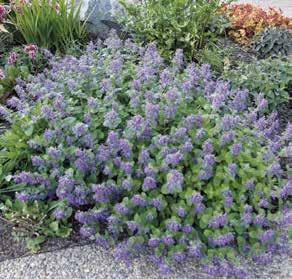
turf, but they offer a visual height like that of a lawn. Once established, these flowering plants require less maintenance, are more beneficial for the environment, and support pollinators. Read about some of my favorite flowering lawn alternatives below.

YOUR ONE-STOP-SHOP FOR

A resilient ground cover, red creeping thyme, Thymus coccineus, withstands light to moderate foot traffic. Its tiny, herby leaves form a dense mat just a couple inches

above the ground. In summer brilliant red flowers bloom, completely covering the plant. Pollinators love these tiny flowers and deer and rabbits avoid the scented leaves. There are many types of creeping thyme, and all are excellent ground covers for sunny spots with well-drained soil. A great option for shady spots is Pennsylvania sedge, Carex pennsylvanica Thriving in challenging conditions, it will even grow in dry shade under trees. Wispy bright green blades, 6-12″ tall, form a dense ground cover that is difficult for weeds to grow through. While drought tolerant, if kept watered this Missouri native can spread via rhizomes quickly.

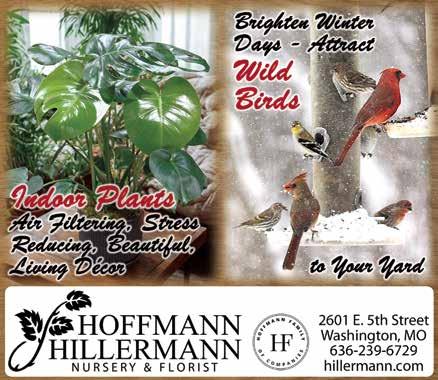

Will tolerate light to moderate foot traffic. ‘Nova Blue’ catmint, Nepeta quickly develops into a 2’ wide circle of hairy silver-blue foliage with blue flowers. Although it spreads rapidly, it won’t get out of hand and will only grow about 4” tall. This is a favorite at my home as it blooms continually May through frost. Deer and rabbits leave it alone and the flowers are loved by bumblebees. Bugleweed, Ajuga excel as a flat ground cover for shady locations. ‘Chocolate Chip’ creates a dense mat of dark foliage leaves. ‘Cordial Canary’ has vibrant yellow leaves. Both have delightful blue spikes of flowers in spring that pollinators adore, and both stay evergreen for most of the year. Bugleweed will tolerate light to moderate foot traffic.
Snow in summer, Cerastium, is choice for those tough spots where other plants
Abby Lapides is owner and a speaker at Sugar Creek Gardens Nursery. She has degrees from the University of Missouri, and is a member of the Landscape and Nursery Association of Greater St. Louis. You can reach her at (314) 965-3070.

struggle–hot, dry areas with poor soil.
Highly valued for its beautiful woolly silver foliage, it was perfectly named as its white flowers completely cover the foliage in late spring and early summer, looking like the morning after an overnight snow. It works fantastically as a low-maintenance ground cover in those hot spots, on slopes, and in other areas you don’t want to drag the hose. Deer and rabbits leave it alone.
An excellent Missouri native in my garden, Robin’s plantain, Erigeron pulchellus, forms a dense mat of hairy foliage that hugs the ground. White to lilac daisies bloom about 6-8” over the foliage in masses in spring and summer. Drought tolerant


once established, this tough ground cover will spread quickly with supplemental watering. It can handle light foot traffic and will lightly rebloom in fall.
When choosing plants consider light exposure, soil conditions and the amount of foot traffic the area will experience. For larger lawn replacements clover and native buffalo grass can be good choices. Visit sugarcreekgardens.com to explore other excellent lawn alternative options.
We Have What You Need!




by Samantha Zale
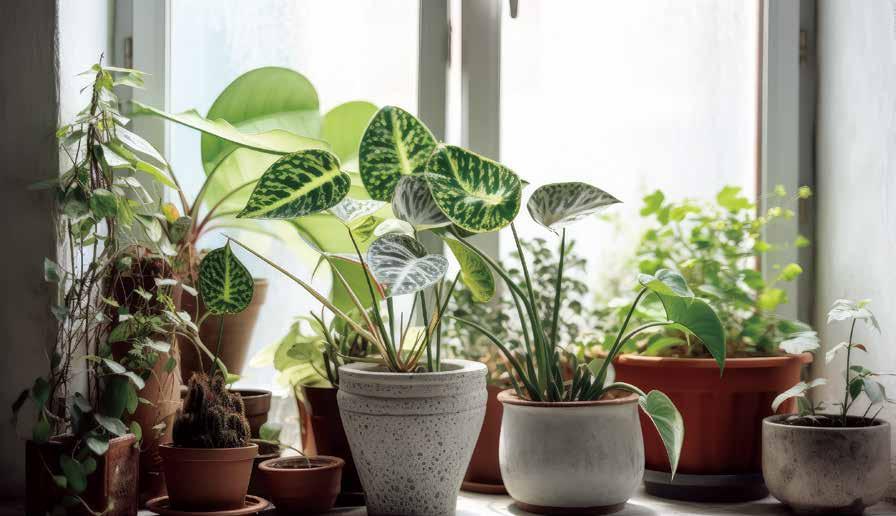
Placing your plants near a window can increase their light exposure in winter, but only do so if the windows are well insulated. Poorly insulated windows can expose plants to cold air and drafts.
As the winter months approach, houseplants can face challenges that can affect their health and vibrancy. During winter, the reduced light, dry air and fluctuating temperatures can all have health impacts on your houseplants. However, with the right strategies, you can help your houseplants survive and even thrive until spring returns. Here’s how to keep your houseplants happy during winter.
Understanding the Challenges of winter
Winter brings specific environmental changes that impact houseplants:
air, creating a less hospitable environment for humidity-loving plants.
3. Fluctuating Temperatures: Cold drafts from windows or nearby forced air vents can cause sudden temperature fluctuations that stress plants, especially tropical varieties. Key tips for overwintering hoUseplants
• Position Your Plants Wisely: The first step in overwintering houseplants is to think about their placement in your home. Pay close attention to windows and forced air vents:
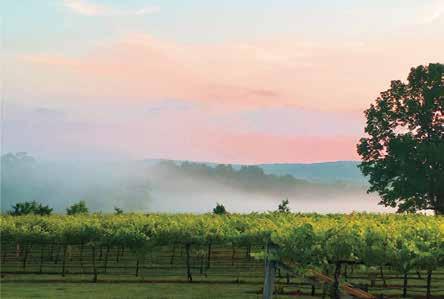
Shorter days and weak sunlight can limit the amount of natural light your plants receive. Many plants need
• Avoid Drafts: Never place your plants directly next to a window, fan or near an air vent. Cold drafts can cause temperature shock and can even damage leaves. It’s better to avoid drafty areas and use supplemental lighting than to have











• Optimize Light: Even though daylight is scarce, plants still need as much light as they can get. Position plants near south or west-facing windows, where they will receive the most indirect light. If natural light is limited, consider supplementing with grow lights.
Maintain proper hUMidity
Many houseplants, especially tropical varieties, thrive in a humid environment. As the indoor air dries out, it’s important to add supplemental humidity:
• Increase Humidity: A humidifier can add moisture back into the air, benefiting both you and your plants. Regular misting or trays of water can also help if a humidifier is not doable.
• Group Plants Together: When plants are grouped together, they can create their own microclimate, leading to higher humidity levels around them.
• Watering Practices: Check the moisture levels of the soil regularly. Overwatering during winter is a common mistake, as plants use less water due to slower growth. Only water when the top inch of soil feels dry to the touch.
teMperatUre Control and air CirCUlation
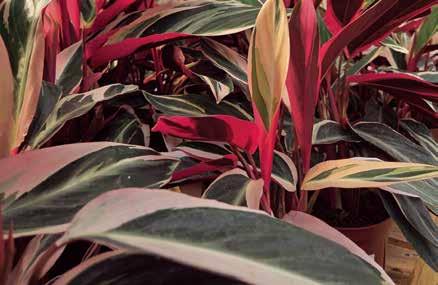
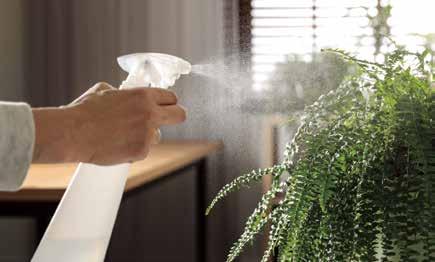
temperatures can fluctuate- nearby doors, windows, fans or radiators.
• Cut Back on Fertilizing: During the winter months, most houseplants go into a dormant or semi-dormant state, meaning they don’t need much food. It’s common to stop fertilizing completely until March, when plants start actively growing.
• Keep an Eye on Pests: It is still important in the winter to keep an eye out for pests. It’s normal to see critters such as spider mites, aphids, scale and mealy bugs over winter. Regularly check the undersides of leaves and crevasses, look for honeydew and use an isopropyl alcohol solution for a quick treatment.
Overwintering houseplants can seem daunting, but with the right care, your plants can make it through this season in great shape. By carefully considering their placement, providing extra humidity, maintaining consistent temperatures and being mindful of watering, you can create an environment that keeps your plants healthy and happy. As spring approaches, your houseplants will reward you with new growth and fresh vitality. So, embrace the season and enjoy your indoor garden all winter long! Visit your local garden center for inspiration! Happy Holidays!
During the winter, it’s important to maintain consistent temperatures to avoid extreme shifts. Rapid temperature shifts or uncontrolled airflow, can negatively impact many houseplants:
Controlled Air Circulation: Be mindful of keeping air from vents or fans from directly hitting your plants, which can dry out plants and expose them to extreme temperature changes. That said, it’s still important to have controlled air circulation to prevent stagnant air and disease.
Monitor Temperature Fluctuations: Houseplants do best in temperatures ranging from 60-70°F. Avoid spots where

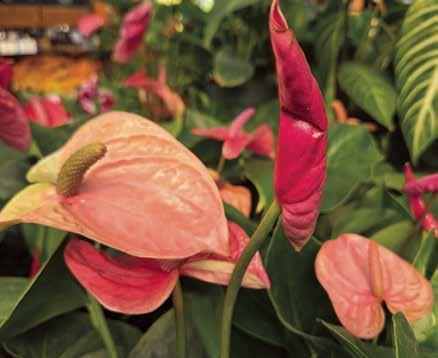
by Sarah Wilcox
As the garden settles in for winter, most gardeners shift from soil and seedlings to evergreens and cozy gatherings. But even as the growing season slows, that instinct to nurture the earth doesn’t fade. Between fall pumpkins, Christmas trees, and festive decorations, the holidays generate a surprising amount of organic material — much of which ends up in landfills, where it can’t break down properly. Without access to oxygen, these materials decompose anaerobically, producing methane — a potent greenhouse gas. When composted instead, they release nutrients back into the soil and help store carbon naturally.
With a gardener’s mindset, the season of giving can extend beyond gifts and gatherings. It can be a time to give back to the soil, keeping natural materials in the cycle of life instead of sending them to waste.

By November, carved pumpkins start collapsing on porches across the neighborhood — and most end up in the trash. Yet pumpkins are almost entirely compostable, making them one of the easiest seasonal decorations to return to the earth.
If your pumpkin wasn’t treated with bleach or coated in paint or glitter, it’s safe to compost. Remove any candles or decorations, cut it into smaller chunks so it breaks down faster, and mix it into your compost pile with dry leaves, straw, or shredded paper. Pumpkins are rich in nitrogen, so they need those “brown” materials for balance. Keep the pile moist but not soggy, and nature will do the rest.
For gardeners without a compost pile, check with your local parks department or composting organization. Many offer free pumpkin drop-offs in late fall. You can also scatter small pieces directly in garden beds and cover them with soil or leaves; they’ll decompose over winter and enrich the soil by spring.
If your pumpkin is still firm and was never carved, painted, or treated, it might have a second life in the kitchen. Roasted pumpkin purée can be used for soups, muffins, or dog treats. However, once a pumpkin softens, molds, or shows signs of bacterial growth, it’s no longer safe to eat or feed to animals. In that case, the best option is to compost it. Composting prevents mold spores or bacteria from spreading while still allowing nutrients to return to the soil naturally.
Give Your christmas tree a second LiFe
When the holidays wind down, many people find themselves dragging a brittle tree to the curb — but that evergreen doesn’t
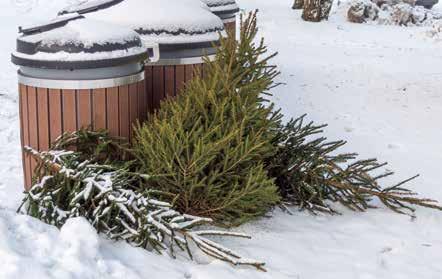
have to go to waste. With a little creativity, it can keep contributing to your garden long after the ornaments are packed away.
If you compost at home, remove all decorations, hooks, tinsel, and lights. Then trim the tree into manageable pieces — the smaller the sections, the faster they’ll decompose. Branches can be laid over perennial beds as insulation against temperature swings or stacked in a corner of the yard to provide winter shelter for birds and small wildlife.
Once the needles have fallen, collect them to use as mulch for acid-loving plants such as blueberries, rhododendrons, and azaleas. The trunk can be chipped into mulch or used as edging along garden paths. Even a few logs left to decay naturally can create valuable habitat for insects that help aerate soil and pollinate plants come spring.
If you don’t have the space or tools to compost a tree, many cities host tree recycling or chipping events in January. The trees are ground into mulch or compost, which is often made available to residents for free — a simple way to ensure your holiday tree returns to the soil instead of ending up in a landfill.
One of the best ways to make your home feel festive — without spending much or creating waste — is to bring the outdoors in. Using natural materials for your holiday décor adds warmth, texture, and a sense of connection to the season. Guests will love the cozy, organic touches, and you’ll love knowing that everything you create can safely return to the earth and enrich your soil when the holidays are over.
Start by foraging in your own backyard or neighborhood for materials. Pinecones, evergreen clippings, holly branches, seed heads, and dried flowers can all be turned into stunning wreaths, garlands, or centerpieces. Add festive pops of color with cranberries, dried orange slices, or cinnamon sticks — simple ingredients that look beautiful, smell wonderful, and can all be composted when you’re done. Twigs tied with twine or clusters of pinecones can be arranged in vases for a rustic yet elegant look that lasts all winter.

If you want to go a step further, try making your own dried flower ornaments or swags. Choose blooms that dry easily, such as statice, strawflower, lavender, yarrow, or globe amaranth. Hang them upside down in a dark, dry space until they feel papery to the touch. Once dried, weave them into wreaths or small hanging arrangements — each one will have its own unique character. When the season ends, they can go straight into the compost, adding valuable organic matter back into your soil.
To make your home feel even cozier, skip synthetic candles and try a natural simmer pot instead. Combine pine needles, orange peels, cranberries, cinnamon sticks, rosemary, or cloves in a pot of water and let it gently simmer on the stove or in a slow cooker. The scent will fill your home with warmth and nostalgia — no artificial fragrances required. When you’re finished, the cooled ingredients can go right into your compost pile, continuing their life cycle in the garden.
This holiday season, let your green thumb guide your celebrations. Choose décor that looks beautiful and gives back. Every pumpkin that feeds the soil, every tree that’s recycled, and every pinecone wreath that returns to nature helps build a cleaner, richer, more vibrant world — one garden at a time.
Sarah Wilcox is the Marketing Manager at St. Louis Composting. A lifelong gardener with a passion for soil health and growing things, she enjoys finding creative ways to stay connected to nature yearround. When she’s not at her desk, she loves spending time in her company’s shared office garden and caring for her growing collection of houseplants.


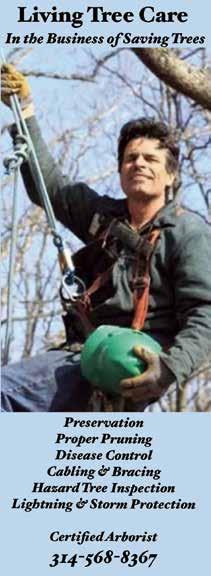

Sugar Creek Gardens
1011 N. Woodlawn
Kirkwood, MO
314-965-3070
SugarCreekGardens.com
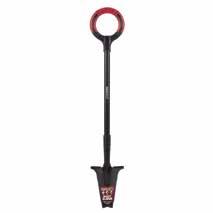
Root Slayer Perennial Shovel
Say goodbye to tough roots and hello to effortless gardening with the Root Slayer 2.0 Perennial Shovel! This amazing tool is designed to make your gardening tasks a breeze. Whether you’re digging, cutting, or trenching, the Root Slayer Perennial Shovel has got you covered. This easy-tomanage shovel cuts roots and hard-packed soil with its sharp, rip-saw teeth.

Garden Heights Nursery, Inc
1605 S Big Bend St. Louis, MO 314-645-7333
GardenHeights.com
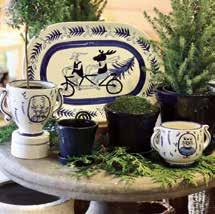
Blue & White Pottery Collection
Liven up any holiday table with the timeless charm of blue and white! From elegant vessels and serving trays to artful pottery, each piece adds a touch of effortless sophistication to your seasonal décor.
Unwrap a fresh holiday look with tablescapes in blue and white, a timeless take on seasonal style.
OK Hatchery
115 E. Argonne Dr. Kirkwood, MO 63122 (314) 822-0083

Talavera Mexican Ceramics
Hand-painted Talavera Mexican luminaries, pots and statues brighten up the holiday season.
Hoffmann Hillermann Nursery & Florist 2601 E 5th Street Washington, MO 63090 636-239-6729 | www. hillermann.com

Modern Farmhouse Solar Lantern Bird Feeders –Bring a unique bird feeder design and some glow to your outdoor spaces! These multifunction bird feeder/lanterns serve as a bird feeder by day and solar light at night. They feature farmhouse lantern styling with a squirrel and predator resistant cage that also protects the seed from larger birds. The barn light styled feeder has a sizeable tray with ample drainage holes to drain moisture and increase air flow to the seed. The taller tube feeder has 4 ports for birds to access the seed.
Both designs have a matte black powder coated finish and a solar panel on the top along with an on/off switch. They also feature easy top loading without removing the cage.
Planthaven Farms
Garden Center
6703 Telegraph Rd. Oakville, MO (314) 846-0078 9504 Olive Blvd. Olivette, MO 314-716-3997
PlanthavenFarms.com

Custom Terrarium
A one-of-a-kind custom terrarium! Thoughtfully crafted and perfect for gifting a little green magic.
Rolling Ridge Nursery
60 N. Gore
Webster Groves, MO (314) 962-3311
Rolling RidgeNursery.com
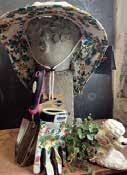
Gloves, Hats and More! Gifts galore for gardeners both inside and out! Gloves, sun hats, hand tools, houseplants. Starting at 24.99.
Effinger Garden Center
720 South 11th St Belleville IL 62220
618-234-4600
www.effingergarden.com

Fresh Greens and More
Fresh greens, wreaths, pine roping, holly and poinsettias. Festive holiday planters. Amaryllis, rosemary and bonsai. Decorated grave blankets and grave sprays. Cut balsam and fraser fir Christmas trees. Live blue spruce, Alberta spruce and white pine trees.
Edg-Clif Farms & Vineyard
10025 Edg-Clif Drive Potosi, Mo 63664 573-438-4741
www.edg-clif.com steffie@edg-clif.com

Edg-Clif Winery Getaway
A weekend adventure in
the country in a unique and authentic farmhouse will fit those special people on your list and a visit to the winery & brewery will match everyone’s style. Choose from 4 unique cottages. Airbnb gift cards available. Staying for the weekend in one of our charming cottages in the Ozarks. Hiking, biking, fishing, boating, riding and exploring are all here for you to experience or try sipping, listening, visiting, learning and gazing at your own pace. All houses have full kitchens, laundry rooms, new bathrooms and kitchens, BBQ’s and fire pits.
Forrest Keeling Nursery
88 Forrest Keeling Lane Elsberry, MO 63343 800-356-2401
ForrestKeeling.com

Children’s Nature Book
Join Grandpa Wayne Lovelace, the wise heart of Forrest Keeling Nursery, on a captivating journey through whispering woods and blooming meadows. Especially for curious kids 7-10, this enchanting tale sparks curiosity and love for the outdoors and living things. Secure your copy this Christmas—every
purchase is a heartfelt donation to the Jillian Anne Young Foundation at JillianYoungMemorial. com.
New Frontiers
101 W. Third St. Alton, IL 62002 618-465-8868
Frontierfurnishings.com

Greenhouse
Every gardener can use a beautiful, practical and functional Western Red Cedar Greenhouse with maintenance-free Azek

Nov. 29th






text
photos by Scott Woodbury


Some plants have evolved to spread and survive in the wild, primarily through the use of rhizomes (stems that spread underground). American feverfew (Parthenium hispidum) and ashy sunflower (Helianthus mollis) notoriously produce few flowers when mature. They use more energy for rhizome and root growth than flower and seed production, a niche strategy that produces great results in nature, and possibly great results in the garden, if you are looking to plant, for instance, a dense ground cover on a difficult hillside. When I see massive patches of ashy sunflower in tallgrass prairies, it’s obvious that something is working for this plant. The same is true of American feverfew, which colonizes in dry glades.
But most gardeners are more impressed by flowers than foliage. Lucky for us, there are spreading plants available in nurseries that bloom nicely, like prairie groundsel (Packera plattensis),

a yellow-flowering, nearly evergreen plant that can be grown as a short, solid ground cover in shade or full sun, though I prefer to weave it with small to medium-sized sedges (like star sedge, Carex radiata and palm sedge, Carex muskingumensis). Keep in mind that when combining with other species in the garden, a few plants of groundsel (of any Packera species) will go a long way. They are clump-forming in year one, then explode from rhizome growth by year two. It may be worth planting the sedges and other low-growing perennials in year one, and then the groundsel in year two.
Wild strawberry (Fragaria virginica) is very similar—and

aggressive as can be—though its stems spread aboveground (stolons). Because of this, wild strawberry can be controlled by cutting off new-grown stolons in early summer when they appear. This is not an easy task, because the stolons appear repeatedly throughout the growing season. It’s better to introduce it with other plant species in year two or three, after the other plants are established. Wild strawberry will then weave itself into gaps and not take over.
Another one that performs this way, but not nearly as assertively, is American beakgrain (Diarrhena obovata), a shade-loving grass with dark green shiny leaves in summer and attractive tan leaves in winter. It isn’t as aggressive as groundsel, and may take three seasons to start suckering. You could grow this as a ground cover, but I like to add other woodland species between it, like Jacob’s ladder (Poleminium reptans), sensitive fern (Onoclea sensibilus), wood poppy (Stylophorum diphyllum), and blue-stem goldenrod (Solidago caesea).
When I mention common milkweed (Asclepius syriacus), half the time the response is “no thanks.” Gardeners know that this plant spreads. I found a couple of tricks that make common milkweed easier to manage. One is to plant it in half-day shade or part shade

Scott Woodbury was the horticulturist at Shaw Nature Reserve for 30 years and stepped down from that position in June 2022. He continues to work on contract for Shaw Nature Reserve to carry out native landscaping education and has launched his own business called Cacalia: Native Garden Design and Wilding. Find suppliers of native plants, seeds, and services at the Grow Native! Resource Guide: www. moprairie.org.
to slow it down. (If you want it to grow like crazy, plant it in full sun). The other is to introduce it after the garden is established. Though common milkweed can send rhizomes out 3 to 5 feet in any direction, it seeks out the gaps in the garden. It’s also easy to pull up unwanted stems when they are waist-high. If you are trying to cover a steep sunny hillside with solid vegetation, try common milkweed with little bluestem (Schizachyrium scoparium) and sideoats gramma (Bouteloua curtipendula). Add some ashy sunflower or American feverfew for a rock-solid hillside planting that will only need to be cut down once a year to keep the trees out.
Lastly, if you have a lot of space and need to cover a large area with plant material, you might consider winged or smooth sumac, two shrubs that spread quickly by rhizomes. Winged sumac (Rhus coppalina) can grow 8 to 10 feet tall and wide. Smooth sumac (Rhus glabra) can reach 15 feet. The brilliant, orange and red fall color can’t be beat, and looks great with big native grasses like big blue stem (Andropogon gerardii), or switch grass (Panicum virgatum), and big perennials like Arkansas blue star (Amsonia hubruchtii) and aromatic aster (Symphyotrichum oblongifolium) that combine into what plantsman Larry Lowman used to call a wild orgy of color in autumn.
Happy gardening y’all!


By Susan M. Reed
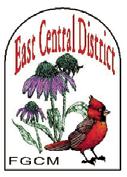
In 1933, a group of nine garden clubs got together and formed the Federated Garden Clubs of Missouri (FGCM). The group’s objectives included conserving natural resources, promoting civic beauty, advancing the art of gardening and horticulture, and coordinating the activities of its member clubs. It joined the National Garden Clubs in 1937, and was officially incorporated in 1952.
Today there are 125 affiliated garden clubs with 2500 members in Missouri. The state clubs are divided into 8 districts with the East Central District encompassing the St. Louis and St. Louis County area with 18 club members. As it celebrates its 90th year as a member of the NGC, East-Central District’s past director Sue Reed volunteered to recount some of the benefits garden club members not only receive, but have given to the community. –Ed.
Looking for a way to connect with other gardeners? A garden club could be the answer – or maybe you could gather a group of neighbors and friends and start your own! That is how most garden clubs began. People who love digging in the dirt and love the natural world around them.
But garden club members do so much more than sit around and admire their own gardens. They develop plans to make a difference in their communities – build butterfly gardens, fill pots in town centers, hold workshops to make floral arrangements or create gifts for nursing homes. Some clubs work with youth groups in schools or churches. Others plant and maintain gardens at historic buildings or volunteer in parks. Trees are planted, highways are cleaned up, scholarships are awarded, programs are given in libraries – if you can think of ways to improve our environment, there is a garden club doing it!
And that’s what member clubs of the East Central District of the Federated Garden Clubs of Missouri have been doing for 90 years! Here are just a few highlights!

Circa 2002, gardeners work on an arch-inspired garden in the Luther Ely National Park adjacent to the Gateway Arch.
• In 1977, led by Fenton Garden Club member Hazel Knapp, the decision to build a new National Garden Club Headquarters in St. Louis was reached. Hazel persuaded the Missouri Botanical
Garden to donate six acres at the south end of their property, along Magnolia Avenue. A quite modern-looking building was built and later expanded. Members added beautiful gardens, including a 9/11 Memorial and Garden, designed and installed by June and Fred Kummer, and dedicated in 2007 at the NGC Fall Board Meeting held every other year in St. Louis.
• In 2002-4 members created a large garden in the Luther Ely National Park across from the Gateway Arch. Designed by Mary Francois Deweese, a member and landscape architect, it mirrored the arch with a series of arches into which were planted hundreds of perennials.
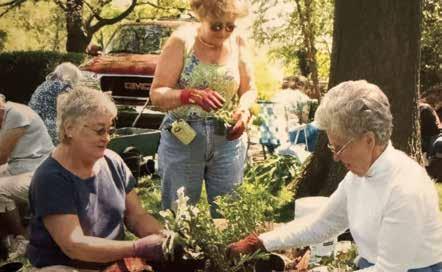
Club members Maxine Clingan, Brenda Todd and Nancy O’Brien work on preparing plants for the Great Perennial Divide in 2007.
• For many years, Gateway Greening, now Seed St. Louis, under the leadership of then Executive Director Gwenne Hayes-Stewart, worked with member club gardeners, who dug, divided, potted, labeled and gave away perennials at The Great Perennial Divide. Some plants were sold as a fundraiser, while most were given away to community gardeners to add some color to their vegetable gardens.
• Members have worked with schools for Arbor Day tree plantings, butterfly and pollinator garden installations to help students learn about and plant more native plants and trees to bring the natural world back into our gardens.
• Many club gardeners have volunteered with Bring Conservation Home, started by the St. Louis Audubon Society to help gardeners improve the wildlife value and sustainability of their landscapes.
• Blue Star Memorial markers have been placed around the country as a tribute to all servicemen and women, past, present and future. This program sponsored by our National Garden Club has been enthusiastically supported in Missouri. Among the twelve Blue Star Markers within the St. Louis City and County, ECD has raised the funds (often with support from the American Legion and other community groups) to purchase and place the handsome markers in the Jefferson Barracks National Cemetery, Soldier’s Memorial, the Veteran’s Home near Bellefontaine, and the Museum of Transportation. Each was dedicated by members and officials through solemn and moving ceremonies. Gardens surround many. Smaller

Left to right, Jimmie Meinhardt (member and National Chair), Sue Reed, assistant director of ECD at the time, and Lorraine Mathies from Southwest Circle, which raised money for the Blue Star Memorial being dedicated here in 1998.
markers were also installed at other sites, then landscaped with perennials and annuals.
• Flower shows and learning to design interesting arrangements has been a central focus of garden clubs since 1935. Art in Bloom at the St. Louis Art Museum began in 2001 featuring 24 designs by 20 garden club members, interpreting works of art throughout the museum. Many other small and large flower shows have been held over the years. For about 20 years, The St. Louis Home and Garden Show at America’s Center featured our shows. These shows teamed up with the St. Louis County Parks Department Children’s Garden Club, which offered free craft projects for children attending the show. These events continue today at the St. Charles Home and Garden Show.
• We in St. Louis have held Environmental Schools nearly every year in March since 1999. These schools are now held on-line and are open to anybody. In 2025, both instructors and students represented all parts of the USA. The next school will be held for four afternoons, March 23-26, 2026.

A floral display welcomes guests to the FGCM state convention in St. Louis in 2023.
• ECD hosted the State Convention in 2023 and a Statewide flower show.
• Finally, each year has provided many opportunities to tour members’ gardens. This year, ECD held Vignette, a special districtwide tour of ten gardens, each with its own special attributes. Money earned from the tour was donated to the American Red Cross for tornado disaster relief. These tours are always open to the public, as are the flower shows and plant sales.
These are just a few memories of the many spanning the ECDs 90 years in St. Louis. If you’re looking for a way to improve your gardening skills, contribute to our community and best of all, build enduring friendships, check out your neighborhood ECD member garden club. They are identified in a list at gatewaygardener.com/clubs-and-societies.com or visit their website at FGCMO.org.
Susan M. Reed has been an active member of the Federated Garden Clubs of Missouri and East Central Division. She has held a number of positions over the years, including ECD director from 1999-2001 and again from 2015-17. She has also been president of her garden clubs,
Forsythia Garden Club and St. Louis County Garden Club. She is currently Yearbook Awards Chair for the ECD.

left to right, Pam Rethy, Kathie Soehngen, Connie Lohse and Carole Lystrom hold a $3900 check representing money raised from Vignettes, a garden tour in June 2025, and donated to the American Red Cross to aid tornado disaster relief.
Start Your Family’s Holidays at the Poinsettia
Sunday, November 23rd from 9am-4pm Greenhouse Tours 10am-3pm



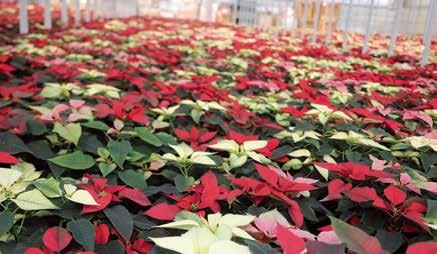

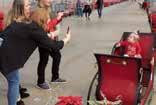

Come see the area’s LARGEST display of poinsettias! Our professional growing staff will assist in self-guided tours and will be happy to answer any questions you may have.
Crafters • Holiday Treats • Santa • Christmas Entertainment Millstadt Gardens
Hoffmann Heimos Greenhouses
6667 Route 158 • Millstadt, IL 62260
(Just minutes from the JB Bridge) (618) 476-9600

Hosted by The Heimos Family, Hoffmann Heimos Greenhouses, Millstadt Gardens, and Micky’s Minis. A percentage of sales to benefit the Millstadt Optimist Youth Club
